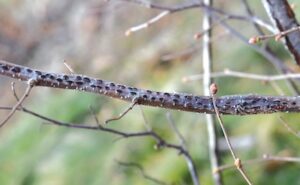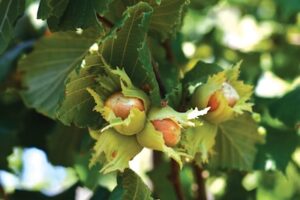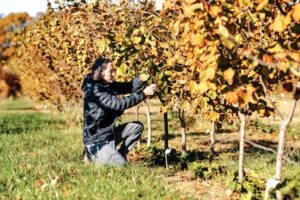
March/April 2025
Gaining new ground
For the first time, hazelnut orchards are being planted on the multi-acre scale in New Jersey, as well as parts of Pennsylvania, New York, Ohio and other eastern locations.
Using numbers of trees sold based on royalty reports, around 200 acres have been planted with Rutgers University cultivars alone. Plus, additional cultivars and seed-propagated trees available from private eastern nurseries show strong sales in recent years. Responses to a recent grower’s survey conducted at Rutgers also indicated 270 acres have been planted across the eastern U.S., with 105 acres in New Jersey alone.
While this acreage is small compared to commercial hazelnut farms in Oregon, it demonstrates significant interest and investment in hazelnut production in eastern regions.
The establishment of grower cooperatives with a focus on hazelnuts in New Jersey (Avellana Agroforestry Cooperative), Pennsylvania (Keystone Tree Crops Cooperative) and New York (New York Tree Crop Alliance Cooperative) further signify that momentum is building for eastern production of this crop.
Disease roadblocks

blight (EFB) can kill a susceptible hazelnut
tree just three to four years after exposure. Photo courtesy of Thomas Molnar/Rutgers University.
There have been attempts to grow European hazelnuts — also called filberts (Corylus avellana) — in the eastern U.S. for more than 100 years. From a climate perspective, hazelnuts are adapted to many parts of the eastern U.S., especially in the relatively mild Mid-Atlantic region. However, there has been one insurmountable roadblock to production: the stem canker disease called eastern filbert blight (EFB).
The cause of EFB, a fungus named Anisogramma anomala, is found naturally occurring east of the Rocky Mountains in association with the wild American hazelnut (Corylus americana), whose range spans much of the eastern U.S.
While EFB typically causes only small, inconsequential cankers on the wild hazelnut, it can be devastating to its European cousin. On avellana, EFB manifests itself as large, perennially expanding stem cankers lined with conspicuous, football-shaped stromata that lead to stem dieback, canopy collapse and eventual tree death.
Wild hazelnut populations are widespread in the eastern U.S. and thus provide a nearly continual source of inoculum to infect susceptible European hazelnuts when planted within their range. Under eastern conditions where pathogen pressure can be very high, EFB can kill a susceptible tree just three to four years after exposure.
Breeding for EFB-resistance
To overcome EFB and increase the growing range of European hazelnut, early plant breeders looked to make crosses between European hazelnut cultivars and local wild hazelnuts. Although the wild species has tiny, thick-shelled nuts, it can exhibit very high tolerance to EFB in addition to improved cold hardiness.
Breeding efforts started in the 1920s and have been continued intermittently since, in an attempt to combine the best of both species into improved, widely adapted interspecific hybrids. In short, this process of developing hybrid hazelnuts into a commercially viable orchard crop has taken longer than expected, and it’s still in process.

Today, considerable efforts to develop hybrid hazelnuts as a widely adapted crop for eastern growers remain underway across multiple institutions, including universities and private nurseries. The good news is, it’s getting much closer to fruition as can be seen through recent work of the Upper Midwest Hazelnut Development initiative and the Hybrid Hazelnut Consortium.
The big jump in planting today comes from recent success with breeding EFB-resistant European hazelnuts. If resistance is available, working within this species in breeding is much easier from the context of nut quality traits and traditional orchard practices. For example, when growing European hazelnuts, existing harvest and processing equipment can be used “off the shelf” with little need for re-engineering. Plus, markets for hazelnuts are already established with existing demand for the crop, especially when grown locally.
Worldwide efforts
In 1996, a project was started at Rutgers to collect hazelnut germplasm from around the world and evaluate its potential for the eastern U.S. The focus was searching far and wide for resistance to EFB for use in a breeding program for locally adapted cultivars.
The Rutgers program collaborated with Shawn Mehlenbacher at Oregon State University (OSU). Oregon was facing similar concerns about EFB and wanted to widen the pool of resistant plant materials available for breeding.
A project was put in place that included sharing diverse plant material from the OSU breeding program for testing in New Jersey, as well as joint collection expeditions where seeds were obtained from around the world and shared for evaluation.
To date, thousands of seedlings from the OSU and Rutgers breeding programs, along with seedlings from foreign collections in eastern Europe, the Caucasus and parts of the former Soviet Union, have been screened in New Jersey. While most trees died from EFB early on, a small percentage thrived, carrying valuable genes for resistance, and have since been used in breeding.
From these efforts, dozens of new sources of EFB resistance have been identified, including plants from Italy, Spain, Russia, Ukraine, Turkey, Georgia, Estonia, Moldova, Poland, Armenia and Azerbaijan. These diverse plant materials have been used in crosses with existing cultivars and elite breeding parents to develop advanced populations from which to select new cultivars.
Looking to the future

Ultimately, these joint efforts led to the 2020 release of the first four cultivars from the Rutgers program, with an additional hybrid cultivar released from the Hybrid Hazelnut Consortium. These include Raritan, Somerset, Monmouth, Hunterdon and the European x American hybrid The Beast, or OSU 541.47. These cultivars were selected for their resistance to EFB, production of high-quality kernels and consistently high crop yields.
These cultivars first became available to growers in 2020, though availability was initially limited. Today, nurseries including Foggy Bottom Tree Farm in Columbus, New Jersey, can supply large numbers of trees. Growers are continuing to plant each year and are organizing in preparation for upcoming nut production in this new region.
Since the eastern U.S. lacks a history of hazelnut production, including necessary infrastructure spanning from harvest to processing to sale, there are many components that require attention to develop a commercially viable industry. However, with new plant material available and acres being planted, along with additional cultivars in breeding pipelines, the future of eastern hazelnut production looks very bright.
Exciting momentum, from growers to value-added producers to consumers, is helping set the stage to make eastern hazelnut production a successful near-term reality.









